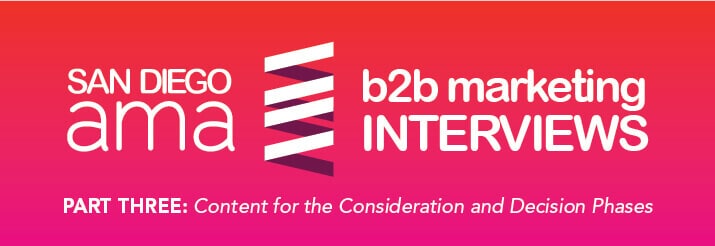The B2B content marketing focus changes throughout the sales funnel. In this third part of an interview by the SD AMA, Jeremy Durant of Bop Design shares how content should be modified for the Consideration and Decision Phases of the sales funnel for B2B companies.
All interviews were hosted by Jimmy Page, Vice President of Content and Analytics, at the San Diego Chapter of the American Marketing Association for the segment, This Week in Marketing powered by wsRadio.com. All recordings can are available on the SD AMA website.
Jimmy: In the last segment, we touched on the transition to the consideration phase a little bit where the prospect starts to invest more time in understanding the solution, and we talked about some mediums that were touching the discovery phase, but also potentially starting to move people into this next phase, this consideration phase. How does the B2B content fit once someone has moved to consideration? What are the new hurdles that the marketer is facing in this new phase? What does it look like from a content standpoint?
Jeremy: So you’re really now working with content going from more rational, kind of metric-driven content, more kind of reasonable content versus more emotional content. This is where you can actually start presenting before-and-afters, let’s say, on a project, because at the end of the day, the buying process is emotional. They want to see what can be.
At the beginning, you’re just giving some stats and educating the client on the buying process and what they should look for. Now you’re getting more into their individual situation, reminding them of potential pain points they could be experiencing with their current situation and then here’s how it could be. That’s what the content needs to go after. That can be before-and-afters. That can be really status quo versus the new way, but really more appealing to their emotional side versus their rational side.
That’s a big thing that from a content perspective, and with a lot of B2B firms, they’ll struggle with that. They’re like, “Well, I’m not selling a Porsche here. It’s not an emotional buy.” I say, “No, absolutely, it is.” If you’re selling to a business owner that’s spending their weekends away from their families because they’re still dealing with some QuickBooks accounting issue that their accounting firm didn’t get done, that is reminding them of that current situation. What could be done through content is a great way to prompt you in the vetting process to get to the decision phase.
Jimmy: Think about a piece of content like a case study. Is that more consideration? Or is that discovery? Or can it be both? I don’t think of it as being emotional. I think of something like that as being rational, but I also think of it as kind of a mid-funnel selling type piece.
Jeremy: It can be both. With a case study, though, you’re typically, yeah, you’re going to have the rational points in there of maybe some metrics, some percentages, but then you’re also going to have the more qualitative information in there of, “Hey, this allows this much more time for this or that,” and you’ve got to remind people of their time and what time could be better spent with loved ones or with a hobby. I think people need to be reminded of that and connected to that.
As you go down the funnel, it’s typically a little bit more hand-holding, so a lot of the content that you’re presenting isn’t just being read remote from you; a lot of times you’re presenting this content and you’re actually guiding a prospect through that content and talking it through. You already know certain personality quirks, certain back story to a particular prospect, so as you’re going through that case study or a webinar or the before-and-afters, you already have notes in your head or wherever that you know you can appeal to the emotional side.
It may just say in the case study, “Hey, save 25 hours a month implementing this new process … Oh, hey, you know with that 25 hours, you know how you couldn’t coach your son’s little league team this year? You can do that next year.” Remind them of those emotional benefits from changing from the status quo to the new way.
Jimmy: Yeah. What’s going through my head at the same time is there’s probably a huge emotional impact in terms of just showing someone, “Here are guys that are similar to you that are winning, and you’re losing right now,” right?
Jeremy: Exactly. Exactly.
Jimmy: I think that’s a great point. Something we haven’t talked about, you talk about hand-holding and how it sort of increases as you move down the funnel. That relates a lot to time and the amount of time that they’re willing to spend with you or spend with your content, right? How do you think about time invested in consuming the content through the funnel and in this consideration phase? How much time do you think you can get from someone, and how are you making those calls when you’re designing the length of a piece of content, whatever it is, audio, video, text?
Jeremy: Keep in mind as you’re going from the consideration and in particular in the decision phase, what you want to do is you never want the content to be remote anymore. Because you’re doing that hand holding, you want to schedule time with that particular client to go over that piece of content. I think a lot of people forget that a proposal, an actual project proposal, is B2B content marketing.
That’s an opportunity to do content marketing and keep in mind, you’re not only just presenting the project components, you’re educating in that proposal about particular time commitments for a certain component piece, the value of that component piece. You’re also presenting in that proposal, typically, case studies, and before-and-afters.
Big mistakes a lot of B2B marketing firms do in the sales process is they allow a proposal to go out just by itself. You need to schedule a meeting, that’s the optimal situation, or you at least need to schedule a call. Until a a prospect is willing to commit time-wise to you presenting that proposal or that piece of content, you don’t send it, because they’re not that serious then.
I think people forget that everything from things that are considered more boring pieces of content, which can be a project schedule, just a sample project schedule just so they can see all the steps involved, that’s going to help in terms of their budget expectation, to even the service agreement. The service agreement’s another big thing. That shows you’re organized and typically mean business, that this isn’t just some fly-by-night organization, but you guys actually have a stated process all the way through from discovery, all the way through measurement.
Jimmy: You said discovery. You said measurement. We’re talking about consideration now. What’s between consideration and measurement? Where do you move after consideration? What does it look like when someone’s moving there?
Jeremy: Yep, so consideration and then you go into decision. That’s where you’re getting into, the content now is highly personalized. You’re actually already discussing, you’re almost assuming the business as it is. You’re assuming that this is going to go to the next step, and that’s when you’re presenting the project schedule and “Hey, how many days are allotted for each step? Here’s the service agreement and here’s our payment terms.”
I think a lot of people say, “Oh, that’s not B2B content marketing.” Absolutely, it is content marketing, because once again, you’re showing them, “Hey, we have a defined set of steps, not only once you start with a project schedule, but even with our service agreement, we actually have a process. We’re very organized in the way we bill. We have a payment schedule.”
Things like that, once again, what’s the whole point of B2B content marketing? Building credibility and gaining, and hopefully, having the client have peace of mind to commit to you over someone else, so yeah, when you look at that decision phase, it’s typically a little less the flashy content marketing. It’s just more content that you’re going to show that could be post-commitment that just assures them once again you guys know what you’re doing.
Also, you may have a couple calls here and there with other influencers. We talked about that sphere of influence. In the B2B sales process, you have people that aren’t the primary buyer, but they have a lot of influence. I was talking about, “Hey, you’re working with the VP of Sales, but you also have that CFO and COO that are involved.” Typically you’re going to need to on calls with them, and that’s where that other content comes into play, payment terms, things that are going to help ease their concern of going to the next step.
Jimmy: It’s very interesting that I think you just named a ton of things that are on people’s minds in this phase, and especially the salespeople, but not on their minds as being related to content. Obviously, it’s closing phase that you’re discussing now. It’s the biggest deal. It’s sort of the hardest piece to get past because it’s where revenue starts coming, right after this phase. What are the typical reasons that you see someone falling out that can be plugged by content? How is content fixing these problems in a direct way?
Jeremy: Two major problems that come up in the decision phase where you’ve already presented the proposal, most of time you’ve already sent the service agreement and you think they’re ready to move forward, the number one is low priority. All of sudden they’ve just deemed this, like, “Hey, we wanted to go through this and now it’s not that big of priority.”
The client could be a little disorganized, which can be a red flag anyway and can be a disqualifier because if they’re disorganized now, how are they going to be through the process. If you’re trying to get their QuickBooks from them every month or whatever, if you’re trying to work with them every month, if they’re already this bad now, this is a preview of how they’re going to be.
But on the low priority side is, they’ve just deemed this, “Hey, this isn’t a priority anymore.” We also have that last-ditch content of the process. You’ve got to remind them of the opportunity cost of making this a low priority, of indecision.
Also, keep in mind, B2B content marketing is literally just going out and it’s on the fly, literally going out to their competition and just reminding them, “Hey, this particular company just did this. Did you see this?” It’s third-party content that could just be news item that you see that they, that that particular competitor is a thorn in their side, and they need to be reminded of the opportunity cost of staying the same versus making a decision.
Also, lack of budget once again can be a thing where they thought they had the budget, then they don’t. Once again, it goes back to that opportunity cost. A lot of this isn’t going to be off-the-shelf content anymore. I think a lot of people think that, but really cater with more content specific to that client and reminding them of the opportunity cost of indecision.
Find out more about B2B content marketing and how to measure the success of your content through the phases of the sales funnel in Part IV of this interview with the SD AMA.



